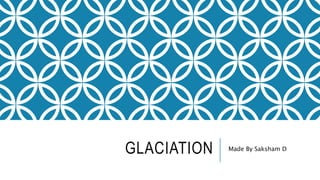
Glaciation-saksham.pptx
- 1. GLACIATION Made By Saksham D
- 2. 10. FACTS ABOUT GLACIERS 1. Approximately 10 percent of the Earth is covered by glaciers; during the last Ice Age, they covered one-third of the Earth’s surface. 2. Glacier ice is the largest reservoir of fresh water on the planet, storing an estimated 75 percent of the world’s supply. 3. Glaciers are found in 47 countries. 4. A glacier can range in length from the equivalent of a football field to more than 100 miles. 5. The Antarctic ice sheet is actually a glacier and has existed for at least 40 million years. If it were to melt in its entirety, sea levels would rise 210 feet worldwide, according to the U.S. Geological Service. 6. Though it sits on the equator, Mount Kilimanjaro is glaciated. 7. On steep slopes, a glacier can be as thin as 50 feet. 8. Mountain valleys are typically “V” shaped before being taken oven by a glacier; during glaciation, the valley widens and deepens and thus becomes "U" shaped. 9. A single glacier ice crystal can grow to be as large as a baseball. 10. Alaska is estimated to have more than 100,000 glaciers. Most remain unnamed.
- 3. GLACIERS Glaciers are massive bodies of slowly moving ice. Glaciers form on land, and they are made up of fallen snow that gets compressed into ice over many centuries. They move slowly downward from the pull of gravity.
- 5. ICE EROSION Snow deposited at high elevations has potential energy that is converted into energy of motion when it is converted to ice and flows as a glacier. A glacier that flows down slope is a powerful erosive agent. The movement of glaciers predominantly erodes by abrasion/scouring and plucking. In the abrasion process, debris in the basal ice scrapes along the rock surface, polishing and gouging the underlying rocks, while in the process of plucking glaciers cause pieces of bedrock to crack off and be incorporated in the flowing ice. These processes usually combine erosion and transport by a water network beneath the glacier.
- 7. DEFINATION OF MORAINE A moraine is any accumulation of unconsolidated debris (regolith and rock), sometimes referred to as glacial till, that occurs in both currently and formerly glaciated regions, and that has been previously carried along by a glacier or ice sheet. It may consist of partly rounded particles ranging in size from boulders (in which case it is often referred to as boulder clay) down to gravel and sand, in a groundmass of finely-divided clayey material sometimes called glacial flour. Lateral moraines are those formed at the side of the ice flow, and terminal moraines were formed at the foot, marking the maximum advance of the glacier. Other types of moraine include ground moraines (till-covered areas forming sheets on flat or irregular topography) and medial moraines (moraines formed where two glaciers meet).
- 8. DEFINATION OF CORRIE A corrie is a horseshoe-shaped valley which is formed through erosion by ice or glaciers. Corries are north-facing, away from the sun which stops the ice from melting. As snow and ice build-up, the underlying rock is eroded. The formation of corries happened a long time ago, during the last ice age.
- 9. DEFINATION OF PYRAMIDAL PEAK A pyramidal peak, sometimes called a glacial horn in extreme cases, is an angular, sharply pointed mountain peak which results from the cirque erosion due to multiple glaciers diverging from a central point. Pyramidal peaks are often examples of nunataks.
- 10. DEFINATION OF ARETE An arête is a knife-edge ridge. It is formed when two neighbouring corries run back to back. As each glacier erodes either side of the ridge, the edge becomes steeper and the ridge becomes narrower, eg Striding Edge found on Helvellyn in the Lake District. A pyramidal peak is formed where three or more corries and arêtes meet.
- 11. DEFINATION OF KAME A kame is a geological feature, an irregularly shaped hill or mound composed of sand, gravel and till that accumulates in a depression on a retreating glacier, and is then deposited on the land surface with further melting of the glacier.
- 12. DEFINATION OF FORMATION A formation, or rock formation, is the fundamental unit of litho stratigraphy. A formation consists of a certain number of rock strata. They have similar lithology (rocks), sedimentary facies (appearance) or other properties.
- 13. DIFFERENCE BETWEEN U-SHAPED AND V-SHAPED VALLEYS U-shaped and V-shaped valleys have distinguishing features which make them different. U-shaped valleys are unique as they have much broader bases with steep and straight walls compared to typical V-shaped valleys, which have narrow bottoms and steep walls having V-shape in the cross-section.
- 15. BEFORE GLACIATION AND AFTER GLACIATION